Lincoln
The last stop on this whirlwind trip was to the city of Lincoln to see both the castle and the cathedral. Needless to say, we were unable to see both. By the time we were finished touring the cathedral, the castle was no longer admitting visitors. So we weren't able to see one of the 4 original copies of the Magna Carta. (Sigh. Luckily, we had a chance to see another original at Salisbury Cathedral in March.)

Here was our first view of Lincoln Cathedral as we were walking down Eastgate from the car park. This is the east tower, of course.

The west front of the Cathedral is so large, it wouldn't fit in one picture. Here, then, is a picture of the front of the guidebook so you can see what it looks like!

These three arches are all that remains of the original Norman Cathedral built in the mid-11th century.

In this view you are seeing the tops of the 3 Norman arches and the two towers at the west front.

This view is of the north side from the west front. . .

. . . and here is the south side including the Galilee Porch.

This is the Exchequer Gate; it lies just in front of the Cathedral (preventing anyone from taking a picture of the whole west façade without a special lens).

From the Exchequer Gate you can see the walls of Lincoln Castle, right across the town square from the Cathedral.
 This was a real treat: this store, on Steep Hill close to the Cathedral and Castle, is Imperial Teas. The small shop was lined, wall to wall and floor to ceiling, with teas of every kind, specializing in Asian varieties. There were at least 10 different kinds of Darjeeling teas and at least eight Earl Greys. Of course, we bought some tea.
This was a real treat: this store, on Steep Hill close to the Cathedral and Castle, is Imperial Teas. The small shop was lined, wall to wall and floor to ceiling, with teas of every kind, specializing in Asian varieties. There were at least 10 different kinds of Darjeeling teas and at least eight Earl Greys. Of course, we bought some tea.
Now back to the Cathedral. Here are statues of English kings atop the Great West Door.

Inside the Cathedral now, we came across stone details like the angel pictured here.

Here is the choir. You can see the organ in the background.
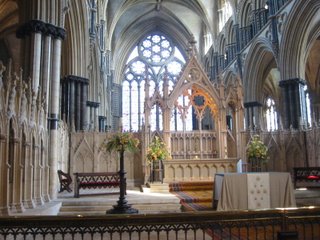
Here is the High Altar with the Great East Window behind it.

The Great East Window was made in about 1275 and is considered the first Gothic eight-light window. It is 59 feet high.

This is the shrine to St. Hugh of Lincoln. The modern-looking 'headpiece' was made in 1986 to celebrate the 800th year of St. Hugh's arrival in Lincoln.

This shrine is called the Easter Sepulchre. It's a rare example of a representation of the tomb of Christ. You can see three knights in the stone carving shown guarding the tomb to prevent the disciples from stealing Jesus's body.
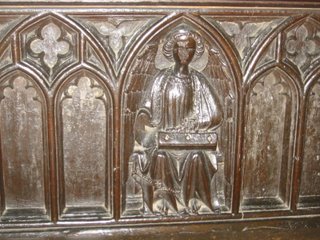
The next two pictures show details on the front panels of the choir stalls. Here is an angel playing a portable organ. . .
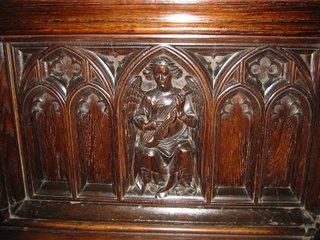
. . . and this shows an angel playing a lute. Aren't they beautiful?
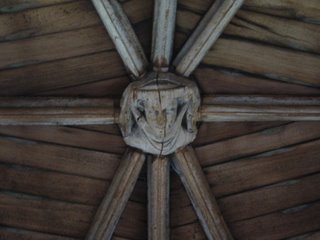
We found this Green Man boss in the cloister ceiling.

Here's another great cloister boss of a Green Man.

Here is a picture of the west tower seen from the cloister.

This is a view of the cloister, not as large as many we have seen.

The Lincoln Cathedral's Chapter House, pictured here, will soon be quite famous. Part of The Da Vinci Code was filmed here!
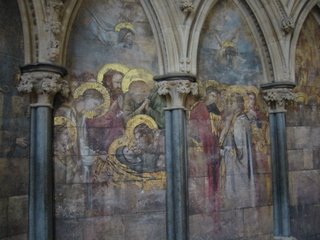
Doesn't this artwork look stunning? It's actually fake. These are painted canvasses that were fitted on the walls of the Chapter House for the filming of the movie.
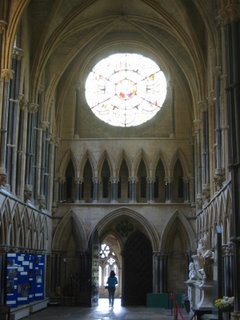
Here is the entryway to the Chapter House. The blue board on the left was an exhibit of pictures, comments, etc. from Tom Hanks, Ron Howard, and others involved in the movie's production.

This is called the Dean's Window and is in the North Transept.

The Bishop's Eye Window is opposite the Dean's Eye Window, in the South Transept.

This is the altar screen at Lincoln.
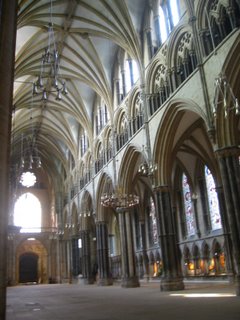
Here is a view of the nave of the Cathedral. As it was getting late, the sun shone through the West Window. For some reason there was no furniture set up on the floor of the cathedral on this day.

After visiting the Cathedral, we decided to walk down Steep Hill again. It is well named. In Roman times, this hill was a grand staircase leading up to the square at the center of the Roman settlement. This medieval building is called the Harlequin. It housed the first theatre in Lincoln, dating from 1744.
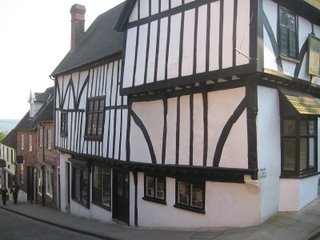
This is the side of the Harlequin.

Here is 'Jews House,' located at the bottom of Steep Hill. It was the home of a wealthy Jewish (banker) named Belaset of Wallingford. In 1290 the Jews were expelled from England and their homes seized. In 1992 (after 702 years), the FIRST meeting of Jews for purposes of worship since 1290 was held here, at Jews Court. Can you believe it?

This is a view looking up Steep Hill.
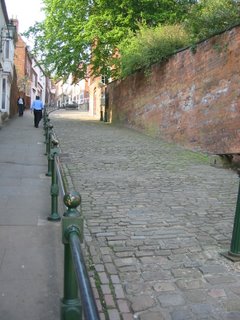
Here's another view. The castle and Cathedral both lie atop this hill. Pilgrims really had to CLIMB to get there.
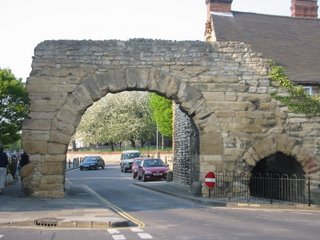
The Roman town was called Lindum Colonia, which was later fused into Lincoln. At the end of Bailgate, the road that extends northwards from Steep Hill is Newport Arch, the north gate of Roman Lindum. It's relatively low clearance indicates how much the level of the town has been raised since Roman times, when the top of the arch was 6 meters off the ground!

This is all that's left of the Roman Forum that originally was here. These pillar remains run down the middle of Bailgate.
 Our last view of Lincoln Cathedral was of this, the outside of the Chapter House.
Our last view of Lincoln Cathedral was of this, the outside of the Chapter House.We wish we had scheduled more time for this trip, but we are very glad we were able to see what we did. We'll just have to come back someday to see the rest.

0 Comments:
Post a Comment
<< Home